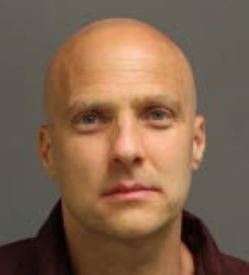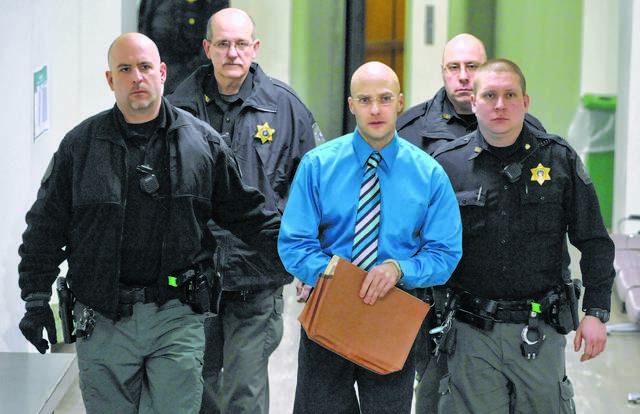Hugo Selenski was convicted in the double murder of Michael J. Kerkowski and Tammy L. Fassett.
Click here to subscribe today or Login.
WILKES-BARRE — Convicted killer Hugo Selenski had no desire of being physically present for his own appeal hearing Wednesday.
Selenski, 47, instead appeared via video conference from the State Correctional Institution at Fayette in Southwestern Pennsylvania for the first day of his Post Conviction Relief Act hearing before Luzerne County Judge Fred A. Pierantoni III.
At the start of the hearing, Pierantoni advised Selenski he had the right to be physically present in the courtroom.
“I do not want to be brought back,” Selenski said.
Selenski is seeking a new trial claiming ineffective assistance of his trial lawyers, Bernard Brown and Edward J. Rymsza, for failing to call certain witnesses and failing to deal with witnesses who testified during his 2015 trial.
A jury convicted Selenski in the May 2, 2002, strangulation deaths of Michael J. Kerkowski and Tammy Lynn Fassett at Kerkowski’s residence in Hunlock Township. Their bodies were discovered June 5, 2003, from a shallow grave outside a home on Mount Olivet Road in Kingston Township.
Selenski, sentenced to two consecutive life terms in prison, was the only witness to testify Wednesday, recalling numerous meetings with Brown and Rymsza to review thousands of pages of documents accumulated during the 12 year investigation.
Selenski’s appellate attorney, Jeffrey Yelen, noted during the hearing Selenski has had numerous defense lawyers and had been held in several prisons.
Rymsza represented Selenski for approximately two years while Brown, who became the lead defense lawyer, was assigned about 11 months before the January 2015 trial.
Selenski said he met with Brown and Rymsza between 24 to 30 times prior to the start of the trial.
“There were concerns about the volume of paperwork and deadlines. Brown expressed concerns he wasn’t ready,” Selenski testified.
Yelen asked Selenski about the difficulty of Brown and Rymsza meeting with Selenski at different prisons.
“They transferred me so much, it was either Mahanoy (City State Correctional Institution) or the Luzerne County Jail. It probably wasn’t the Luzerne County Jail because they didn’t want me there,” Selenski said.
Selenski made national headlines when he escaped from the county correctional facility on Oct. 10, 2003, when he climbed down a rope of bed sheets from the top floor. He surrendered from the Mount Olivet Road home three days later, Oct. 13, 2003.
Selenski was asked about certain witnesses who should had been extensively cross-examined by his trial lawyers.
Two witnesses in particular, Paul Weakley and Patrick Russin, should had been questioned more extensively on cross examination by his trial lawyers, Selenski believes.
Weakley pleaded guilty in federal court to his role in the killings of Kerkowski and Fassett and was sentenced to life in prison. Russin pleaded guilty to two counts of third-degree murder for participating in the shotgun slayings of Adeiye Ossasis “Redman” Keiler and Frank Jermaine “Rudy” James in May 2003.
A jury following a May 2006 trial acquitted Selenski on a criminal homicide charge while a mistrial was declared on a second count of criminal homicide regarding Keiler and James.
During Wednesday’s hearing, Selenski could not recall the names of Keiler and James and only referred to their nicknames.
“Out of respect to their families, I don’t know their names,” Selenski said while being reminded of their identities by First Assistant District Attorney Sam Sanguedolce.
Sanguedolce and Assistant District Attorney Jarrett Ferentino prosecuted Selenski.
Selenski believes Weakley and Russin received preferential treatment in prisons after they agreed to cooperate with prosecutors. Selenski claims Weakley should have been questioned more aggressively during his 2015 trial and Russin’s favorable treatment in prison should have been investigated by his lawyers and private investigator.
Another issue Selenski feels should had been highlighted during his trial was questioning of his uncle, Robert Higdon.
Selenski testified Higdon, referring to investigative reports, did not believe he was responsible for killing Kerkowski and Fassett for money. Higdon, Selenski said, would have loaned him money and in return, Selenski would have paid off the loan by working for his construction business.
Prosecutors alleged Selenski killed Kerkowski for money he later deposited into his then girlfriend’s bank account to cover the down payment to purchase the Mount Olivet Road home in April 2002.
Selenski’s post conviction relief hearing continues at later dates when witnesses are available to testify.
Pierantoni noted testimony should conclude by the end of the year with a decision sometime in early 2021.






